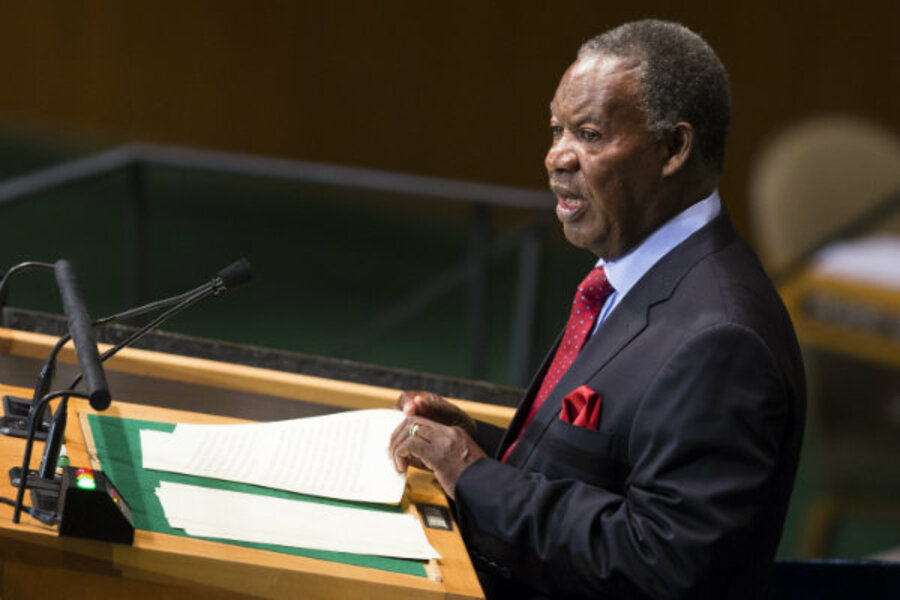How to create jobs in Africa
Loading...
| Hamilton, N.Y. and Livingstone, Zambia
Over the last decade, sub-Saharan Africa has enjoyed its best economic growth since the 1960s, when independence from colonial rule swept the continent. But even this impressive growth rate – 5.4 percent between 2000 and 2010, double the average for the 1970s and 1980s – is not enough to absorb the enormous bulge of unemployed youth. Despite its recent success, the continent needs a free-market makeover.
Zambia epitomizes the challenge – and the opportunity.
When this central-African nation gained independence in October 1964, Zambia had 300,000 full-time jobs for a total population of 3 million. Today, it has fewer than 500,000 jobs, of which nearly half are in the public sector, for more than 13 million people. Region-wide, sub-Saharan Africa will provide one-quarter of the world’s youth by 2025. But nearly two-thirds of this African cohort is already unemployed.
Zambia’s history, like many African countries, is of repeated failure to diversify from its primary export, copper, when times are good, and then scurrying about when the commodity’s price falls.
The country’s vice president, Guy Scott, is refreshingly frank and thoughtful about Zambia’s challenges. He believes that the high costs of borrowing and an overvalued exchange rate mostly explain why businesses battle so hard to grow. Unless these conditions change, he realizes that Zambia will not create the jobs necessary for its burgeoning youth population.
But the high costs of borrowing and slow rate of job creation are symptoms of wider malaise. The expense of doing business, endemic corruption, and the uncertainty of the political environment, says Zambian opposition leader Hakainde Hichilema, known widely as “HH,” are closely related and far more constraining.
He has a point. Take the Chirundu border crossing with Zambia’s southern neighbor, Zimbabwe. Donor money recently refurbished the crossing into what is advertised as a model regional “one-stop-border-shop.”
The nearly two kilometer-long chaotic queue of trucks on the Zimbabwe side, waiting to get into Zambia, hints that things are not quite that perfect yet, an instinct backed up by experience. Passport stampings, vehicle clearance, road insurance, carbon tax, a temporary import permit, district council charge, toll fees, and customs inspection involve a lot of “shopping” between multiple buildings that slows the process down.
Vice President Scott says that Africa should follow the example of China in keeping the costs of money down and its exchange rate weak. He cites the example of a Zambian entrepreneur who made it in manufacturing in China as an example of how Africans can prosper in the right environment.
In spite of their extraordinary energy and tenacity, a key reason why African entrepreneurs find it easier to prosper elsewhere is because of the animus their governments routinely display toward private business.
Old habits die hard. The colonial powers used a highly interventionist state to protect their interests. Most post-independence African leaders used this model to offer patronage to keep their allies on board. Private producers have been consumed by the political imperative to meet expectations, shore up support, and distribute favors.
In Zambia, big business became a target of nationalization in the late 1960s, a costly disaster only remedied by the privatization of the 1990s. Neighboring Zimbabwe has taken the more extreme and recent action of outright seizures in the private sector, cloaked in the nationalist term, “indigenisation.” Despite its obviously calamitous economic costs, this route offers a tempting policy for many African governments, not least Mr. Scott’s.
The border between Zambia and Botswana at the Kazungula ferry across the Zambezi River offers a striking contrast. It shows why Botswana has made dramatic progress since independence – Zambia, only halting forward movement. Botswana started off dirt poor when it gained independence in 1966. It possessed 10 kilometers of tarmac road and had a per capita income of just $70. With fewer than 50 university graduates, literacy was low, and there was scant access to health, sanitation, water, telephone, electricity, public transportation, and other services.
Today its per capita income, at about $14,000, is more than neighboring South Africa’s. Despite its dependence on a single commodity in diamonds, it has ensured both long-term investment and stability through a joint venture with the industry giant De Beers – and much better governance than the continental norm. Botswana is consistently ranked among the safest investment credit-risks on the continent.
At the ferry crossing, the Botswana side – in contrast to Zambia – offers a concrete slipway, neatly tarred road and, the bubble-gum blowing revenue official aside, a courteous, professional staff managing a clear process involving a single road tax payment.
Unlike Zambia and Zimbabwe, where police road-blocks abound as sources of informal “taxation,” Botswana’s are limited to functional checks to curb foot-and-mouth disease.
In Africa’s continuing liberation from the old ways of running the economy, governments embracing the market and making things easier for business will be the next critical step toward creating the jobs the continent so urgently requires.
Jeffrey Herbst is president of Colgate University in Hamilton, NY. Greg Mills directs the Johannesburg-based Brenthurst Foundation. They are authors of the recently launched “Africa’s Third Liberation: The New Search for Prosperity and Jobs."





